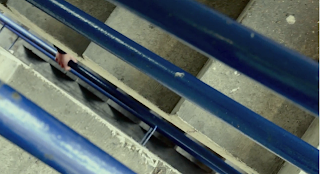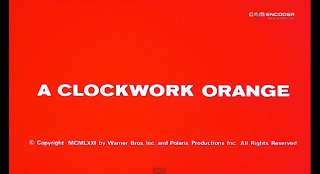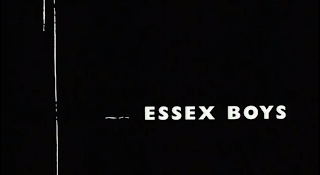Transit:
Our film, Transit, aims to fit in the genre of crime thriller. This is as it revolves around the activity between two characters that seems subsequently illegal, and once we bring a third character (the antagonist) in to the equation suspense is built via his interest in their exchange. Furthermore, we researched and used conventions from films/TV dramas of the same genre in order to form the film into a piece of media that well reflected the crime thriller genre.
Location:
 |
| An exterior shot of Anglia Square car park, showing it's resemblance to the council estate on "Kidulthood" |
| London council estate, "Kidulthood" |
Within a thriller opening, location plays a key part in setting the scene and allowing the action to flow naturally. Our group decided that in order to properly connote the action of Transit, we should set the opening in an area that was old, unglamorous and urban. This is as we wanted to give Transit a gritty and un-nerving feel similar to that of "Kidulthood" and TV drama "Top Boy", whereby, the action takes place primarily in council estates. Therefore, we decided to use Anglia Square car park as the location for our opening.This is as the car park has not been renovated since the early 1970's, ultimately leaving it as a derelict and degrading building. Additionally, the multi-storey car park was closed down, therefore leaving it completely empty. Both of these aspects are the reason that we chose this location; it portrays ideas of bleakness and isolation which are common within media texts such as "A Clockwork Orange" and "Essex Boys".
 |
| An interior shot of the stair well in Anglia Square car park, showing the boarded up level connoting the claustrophobic and corrupt aspects. |
Additionally, the main influence on our choice of location was the music video for "Angel" - Massive Attack. This is as it is set out as if it were a thriller film and executes the notion of being followed brilliantly, whilst also providing great examples of chiaroscuro lighting.
Lighting:
 |
| A close-up of Hanna from our film, Transit, showing our use of chiaroscuro lighting, the dark shadow could connote Hanna's imitate fate. |
 |
| An example of chiaroscuro lighting from "13 Tzameti". |
Our thriller opening uses generic conventions of lighting in order to establish the thriller genre, this is as within the car park we utilised the availability of artificial/non-ambient lighting, which in turn acted as a great source of chiaroscuro lighting. Noir or chiaroscuro lighting is commonly utilised within the thriller genre, particularly in classic crime or neo-noir thrillers in order to increase drama and suspense by engulfing most of the mise-en-scene in darkness and lighting subject matter, connoting that the character is surrounded by threat. For example, in french neo-noir thriller "13 Tzameti", chiaroscuro lighting is used in a scene where there is a russian roulette game between 13 men. Through the use of this type of lighting within our thriller opening, we have referenced films that influenced our decisions when researching and planning.
Furthermore, we were able to make intertextual links through the use of lighting, which in turn, allowed us to stronger connote the consequent actions of our opening via the reference of "Essex Boys". For example, when Bill is driving up the car park ramps, a bar of light is reflected on his windscreen. This references the opening of "Essex Boys", whereby, Billy is driving Jason around and when going through a tunnel, light is reflected in the same way. The reason that we utilised lighting in order to create this link was to forebode the same meaning, whereby, in "Essex Boys" the light bars connote that Billy is most likely to end up in jail as a result of Jason's actions, and within our thriller opening Bill's actions would most likely result with him going to jail.
 |
| An example of our intertextual link from Transit (left) to "Essex Boys"(right) |
Soundtrack:
Our soundtrack was inspired by the crime thriller, "Drive", specifically from the opening getaway scene where music plays a key part in building tension ("Tick of the Clock" - Chromatics). The reason that we chose a soundtrack that resembled this was that we wanted to slowly build tension, and much like in "Drive" our opening soundtrack utilises this via the introduction of percussion instruments. Furthermore, within the soundtrack "Tick of the Clock" the music dies down near the middle to symbolize the tension reaching a climatic point and then becomes louder to symbolize the tension returning to is previously built form. This similar style is portrayed in the soundtrack that we picked "For Whom the Bell Tolls" - Oliver Ledbury, and therefore we picked this to convey the same meaning. For example, the first time John see's the white van some of the instruments cut out, making the mise-en-scene seem eerie and suspicious.
http://www.audionetwork.com/production-music/for-whom-the-bell-tolls-3_61166.aspx
Our soundtrack, "For Whom the Bell Tolls" - Oliver Ledbury
"Tick of the Clock" - Chromatics ,the song that influenced our choice of soundtrack.
The opening shot from our thriller, Transit.
|
Tracking shot of Josh, used near the beginning
of "Animal Kingdom". |
In order to best reflect the action, we used a wide variety of camera angles and shot types in our thriller opening. For example, when our film opens we used a a tracking mid close-up from behind Jon of him walking up some steps of the exterior car park. The tracking notion of this shot connotes the possibility that John is being followed thus increasing suspense. This specific shot was influenced by Australian crime thriller “Animal Kingdom”, where the camera tracks Josh (the main character) up a similar staircase. This intertextual reference adds further information about the character. Like Josh, John seems to be walking into a dangerous, predatory world of thugs and gangsters. In terms of story, Josh walks up the stairs just after his mother has died beside him from a drugs overdose. Like Josh in Animal Kingdom, John in our film Transit is isolated and possibly confused, and like Josh has some hard lessons to learn. We used tracking shots in our thriller film in order to position the audience with the character, and although not a generic convention of the genre, I feel it was effective in centring the action around the protagonist.
 |
| Extreme close-up of Beatrix's eyes from "Kill Bill" |
Extreme close-up of Bill's eyes from our thriller
opening, Transit. |
Furthermore, we used a range of close-ups in order to keep the mise-en-scene tight and therefore increase the pace of the action, additionally; we used them to connect the audience with the characters emotions. For example, we used an extreme close-up on Bill's eyes as an introduction of his character to the film. Using this type of shot we were attempting to make Bill appear more threatening, therefore establishing him as a more intimidating character. Although extreme close-ups are not restricted to the thriller genre, they are often utilised in order to engage to audience with the characters feelings. For example, "Kill Bill" is an action thriller that frequently uses this type of close-up in order to establish Beatrix's anger.
 |
Tilt, Birds-eye shot used in our thriller opening.
|
| Tilt shot of Harry Lime's shadow, "The Third Man". |
We also used a tilt shot in order to convey the location as nightmarish and dangerous. For example, when John is starting to walk up the interior steps of Anglia Square car park, we used a bird-eye tilt to show his hand on the rail. Using the tilt allowed us to portray the idea that John was now trapped (indicated by the array of out of line stair rails in the mise-en-scene) additionally, the birds-eye view connotes that John's vulnerability. Furthermore, through the tilt shot we have used generic conventions of the thriller genre, this is as the tilt shot is often used to disorientate and confuse audience in order to connote fear within the mise-en-scene. For example, noir thriller "The Third Man" consistently uses the tilt shot in order to emphasise Harry Lime's alienation in a foreign environment. However, I would argue that we have challenged the generic tilt shot by portraying it from a birds-eye view, which further connotes the nightmare of the character.
Soundtrack:
Our soundtrack was inspired by the crime thriller, "Drive", specifically from the opening getaway scene where music plays a key part in building tension ("Tick of the Clock" - Chromatics). The reason that we chose a soundtrack that resembled this was that we wanted to slowly build tension, and much like in "Drive" our opening soundtrack utilises this via the introduction of percussion instruments. Furthermore, within the soundtrack "Tick of the Clock" the music dies down near the middle to symbolize the tension reaching a climatic point and then becomes louder to symbolize the tension returning to is previously built form. This similar style is portrayed in the soundtrack that we picked "For Whom the Bell Tolls" - Oliver Ledbury, and therefore we picked this to convey the same meaning. For example, the first time John see's the white van some of the instruments cut out, making the mise-en-scene seem eerie and suspicious.
http://www.audionetwork.com/production-music/for-whom-the-bell-tolls-3_61166.aspx
Our soundtrack, "For Whom the Bell Tolls" - Oliver Ledbury
Enigma:
Many thriller films and TV Dramas use enigmas within them in order to keep the audience guessing what's going to happen, they build suspense and evoke twists within the plot line. Utilising these enigmas can be particular effective within the opening of a thriller film, as it can fixate the audience and hold their interest for the entirety of the film. This is why our group decided to introduce a few enigmatic ideas.
Firstly, the antagonist, Bill, can be seen as an enigma as the only visible shots of him that are featured in the opening are the extreme close-up of his eyes, and his boot in the elevator. This leads the audience to only assume Bill's appearance as there is no clear interpretation of him; we created Bill as the enigmatic character in order to give the assumption that we don't know why he's provoking the other two characters. Furthermore, we were inspired to form this enigma based on the antagonist in "Kill Bill", this is as within the first film you don't see Bill but only potions of his body, such as hands and feet; therefore, we wanted to reference this through the use of the same name and idea.
 |
| For example, Bill's boot in the opening of "Kill Bill" on the left. Additionally, Bill's boot from our film, Transit, on the right. |
| Vince Vega looking in the briefcase, "Pulp Fiction" |
 |
| John having a look at the note on Hanna's body. |
Conventions of the opening to a thriller film:
In order to best establish our production as the opening to a thriller film, we had to take into consideration the placing of the titles, soundtrack and cliffhanger in order to keep the audience watching.
Firstly, we decided to begin the soundtrack during the opening production title. This technique is used in films such "Once Upon A Time In America", whereby, "God Bless America" - Irving Berlin plays during the opening credits. The reason for utilising this is in order to establish that the film has begun, connecting the audience with the mise-en-scene before the footage is actually on screen. Furthermore, this is effective in delving the audience straight in to the action, particularly with our thriller film, as the soundtrack pulsates once when the production credit shows and then a second time as the action begins.
 Secondly, we used a bold, sans serif font in order to portray the names of the cast, crew and producers of our thriller opening. This is as we felt serif fonts would take away from the grit of the action, as the tailed letters looked quite traditional and sophisticated, additionally, we made the font bold in order to make it seem more threatening. Our choice of font style was influenced by the opening credits to thriller such as "A Clockwork Orange" and "Essex Boys", both of which use bold, sans serif fonts within their opening sequence. In addition, we placed the credits within the first few exterior shots of the location, this was in order to properly establish that our film was in fact a thriller opening as apposed to a trailer for a feature length film. Furthermore, thrillers such as "Se7en" and "Jackie Brown" place the credits within the opening scenes of the feature length film.
Secondly, we used a bold, sans serif font in order to portray the names of the cast, crew and producers of our thriller opening. This is as we felt serif fonts would take away from the grit of the action, as the tailed letters looked quite traditional and sophisticated, additionally, we made the font bold in order to make it seem more threatening. Our choice of font style was influenced by the opening credits to thriller such as "A Clockwork Orange" and "Essex Boys", both of which use bold, sans serif fonts within their opening sequence. In addition, we placed the credits within the first few exterior shots of the location, this was in order to properly establish that our film was in fact a thriller opening as apposed to a trailer for a feature length film. Furthermore, thrillers such as "Se7en" and "Jackie Brown" place the credits within the opening scenes of the feature length film.  Thirdly, we placed the title of our film on the cliffhanger of our thriller opening. Although, in doing this there was a risk that our production may look like a trailer for a feature film as apposed to an opening, however, I feel that the title is a lot stronger at the end of the sequence in comparison to the middle as it throws the audience right into the film. Furthermore, other thrillers such as "Pulp Fiction" have utilised this technique and therefore we took influence of this in considering our title placement.
Thirdly, we placed the title of our film on the cliffhanger of our thriller opening. Although, in doing this there was a risk that our production may look like a trailer for a feature film as apposed to an opening, however, I feel that the title is a lot stronger at the end of the sequence in comparison to the middle as it throws the audience right into the film. Furthermore, other thrillers such as "Pulp Fiction" have utilised this technique and therefore we took influence of this in considering our title placement. Unfortunately, the clip cuts out before the title appears. However, the cliffhanger
from this episode of "Utopia" is whether or not the emotionally detached hit man,
kills the young school boy.


























